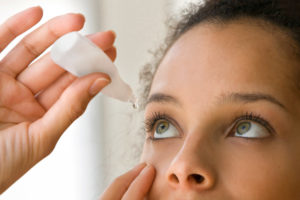January 17, 2022
By Dwight Akerman, OD, MBA, FAAO, FBCLA, FIACLE
 The aim of this clinical trial conducted in Hong Kong on Chinese children was to compare the efficacy of continued and stopping treatment for 0.05%, 0.025%, and 0.01% atropine during the third year, to evaluate the efficacy of continued treatment over three years, and to investigate the rebound phenomenon and its determinants after cessation of treatment.
The aim of this clinical trial conducted in Hong Kong on Chinese children was to compare the efficacy of continued and stopping treatment for 0.05%, 0.025%, and 0.01% atropine during the third year, to evaluate the efficacy of continued treatment over three years, and to investigate the rebound phenomenon and its determinants after cessation of treatment.
The randomized, double-masked extended trial followed 326 children aged 4 to 12 years old originally recruited into the Low-concentration Atropine for Myopia Progression (LAMP) study for three years. At the beginning of the third year, children in each concentration group were randomized at a 1:1 ratio to a continued treatment group and a washout subgroup. Cycloplegic spherical equivalent (SE) refraction and axial length (AL) were measured at four-month intervals.
During the third year, SE progression and AL elongation were faster in the washout subgroups than in the continued treatment groups across all concentrations: -0.68 ± 0.49 diopters (D) versus -0.28 ± 0.42D (P < 0.001) and 0.33 ± 0.17 mm versus 0.17 ± 0.14 mm (P < 0.001) for the 0.05%; -0.57 ± 0.38D versus -0.35 ± 0.37D (P = 0.004) and 0.29 ± 0.14 mm versus 0.20 ± 0.15 mm (P = 0.001) for the 0.025%; -0.56 ± 0.40D versus -0.38 ± 0.49D (P = 0.04) and 0.29 ± 0.15 mm versus 0.24 ± 0.18 mm (P = 0.13) for the 0.01%.
The researchers concluded that continued atropine treatment achieved a better effect across all concentrations during the third year than the washout regimen. Over three years, 0.05% atropine remained the optimal concentration in Chinese children. The differences in rebound effects were clinically small across all three studied atropine concentrations. Stopping treatment at an older age and lower concentration are associated with a smaller rebound.
Abstract
Three-Year Clinical Trial of Low-Concentration Atropine for Myopia Progression Study: Continued Versus Washout: Phase 3 Report
Jason C Yam, Xiu Juan Zhang, Yuzhou Zhang, Yu Meng Wang, Shu Min Tang, Fen Fen Li, Ka Wai Kam, Simon T Ko, Benjamin H K Yip, Alvin L Young, Clement C Tham, Li Jia Chen, Chi Pui Pang
Purpose: (1) To compare the efficacy of continued and stopping treatment for 0.05%, 0.025%, and 0.01% atropine during the third year. (2) To evaluate the efficacy of continued treatment over 3 years. (3) To investigate the rebound phenomenon and its determinants after cessation of treatment.
Design: A randomized, double-masked extended trial.
Participants: A total of 350 of 438 children aged 4 to 12 years were originally recruited into the Low-Concentration Atropine for Myopia Progression (LAMP) study.
Methods: At the beginning of the third year, children in each group were randomized at a 1:1 ratio to continued treatment and washout subgroups. Cycloplegic spherical equivalent (SE) refraction and axial length (AL) were measured at 4-month intervals.
Main outcome measures: Changes in SE and AL between groups.
Results: A total of 326 children completed 3 years of follow-up. During the third year, SE progression and AL elongation were faster in the washout subgroups than in the continued treatment groups across all concentrations: -0.68 ± 0.49 diopters (D) versus -0.28 ± 0.42 D (P < 0.001) and 0.33 ± 0.17 mm versus 0.17 ± 0.14 mm (P < 0.001) for the 0.05%; -0.57 ± 0.38 D versus -0.35 ± 0.37 D (P = 0.004) and 0.29 ± 0.14 mm versus 0.20 ± 0.15 mm (P = 0.001) for the 0.025%; -0.56 ± 0.40 D versus -0.38 ± 0.49 D (P = 0.04) and 0.29 ± 0.15 mm versus 0.24 ± 0.18 mm (P = 0.13) for the 0.01%. Over the 3-year period, SE progressions were -0.73 ± 1.04 D, -1.31 ± 0.92 D, and -1.60 ± 1.32 D (P = 0.001) for the 0.05%, 0.025%, and 0.01% groups in the continued treatment subgroups, respectively, and -1.15 ± 1.13 D, -1.47 ± 0.77 D, and -1.81 ± 1.10 D (P = 0.03), respectively, in the washout subgroup. The respective AL elongations were 0.50 ± 0.40 mm, 0.74 ± 0.41 mm, and 0.89 ± 0.53 mm (P < 0.001) for the continued treatment subgroups and 0.70 ± 0.47 mm, 0.82 ± 0.37 mm, and 0.98 ± 0.48 mm (P = 0.04) for the washout subgroup. The rebound SE progressions during washout were concentration dependent, but their differences were clinically small (P = 0.15). Older age and lower concentration were associated with smaller rebound effects in both SE progression (P < 0.001) and AL elongation (P < 0.001).
Conclusions: During the third year, continued atropine treatment achieved a better effect across all concentrations compared with the washout regimen. 0.05% atropine remained the optimal concentration over 3 years in Chinese children. The differences in rebound effects were clinically small across all 3 studied atropine concentrations. Stopping treatment at an older age and lower concentration are associated with a smaller rebound.
Yam, J. C., Zhang, X. J., Zhang, Y., Wang, Y. M., Tang, S. M., Li, F. F., … & Pang, C. P. (2021). Three-Year Clinical Trial of Low-Concentration Atropine for Myopia Progression Study: Continued Versus Washout: Phase 3 Report. Ophthalmology.
DOI:https://doi.org/10.1016/j.ophtha.2021.10.002













